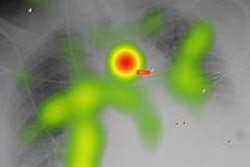
Radiologists can be faster and achieve the same level of diagnostic performance on one 8-megapixel PACS display as they can using a common dual 5-megapixel display configuration, according to research published online recently in the Journal of Digital Imaging.
In a study involving six radiologists who viewed 60 mammographic cases on both types of displays, Elizabeth Krupinski, PhD, of Emory University found no statistical difference in diagnostic accuracy between the two workstation configurations. What's more, the radiologists took less time to interpret the mammograms with the 8-MP display.
"A single 8-MP display, properly calibrated and used in the appropriate radiology viewing environment, is equivalent to two side-by-side 5-MP displays for accurately interpreting mammographic exams," Krupinski wrote. "This configuration may actually present some advantages in terms of reduced visual search time and more efficient visual search."
One or two displays?
Radiology workstations typically have two monitors, and even slight differences in adherence to minimum display standards could result in images appearing very different. This could potentially lead to interpretation errors, Krupinski noted. Viewing images on multiple monitors can also cause physical complaints such as neck, back, and shoulder pain.
Now that a number of manufacturers are producing high-resolution widescreen displays, a single display option is quite feasible, she wrote. To determine if there are any performance differences, Krupinski sought to assess diagnostic accuracy and reader efficiency as a function of display and display layout (JDI, October 31, 2016).
The study used an 8-megapixel display (RadiForce RX850, Eizo) with no bezel and dual 5-megapixel displays (RadiForce GX540, Eizo) with a bezel. All displays were calibrated to the DICOM Grayscale Standard Display Function and the ambient room lights were set to 25 lx.
Each of the six mammographers -- four board-certified mammographers, one mammography fellow, and one senior resident about to enter a mammography fellowship -- viewed 60 mammography cases, first on one of the display configurations and then again three weeks later on the other display configuration. After first deciding whether a case was normal or abnormal, the mammographers reported their diagnostic confidence level on a six-point scale.
Of the 60 cases, 40 had single biopsy-proven malignant lesions, including 20 masses and 20 microcalcification clusters. The lesions ranged from subtle to moderately subtle, according to Krupinski. The remaining 20 cases did not have lesions.
Krupinski also performed an additional study that recorded radiologist eye positions on a subset of 15 cases, which included five masses, five microcalcifications, and five normal cases. The same six radiologists read these cases at least three months after the main diagnostic study.
Similar results, less time
After performing multireader multicase receiver operator characteristics (ROC) analysis, Krupinski found no difference in mean diagnostic performance between the two display configurations:
- Mean diagnostic performance on dual 5-megapixel displays: 0.849
- Mean diagnostic performance on single 8-megapixel display: 0.823
The difference wasn't statistically significant (p = 0.0891). However, the radiologists required significantly less viewing time (p = 0.0002) on the single 8-megapixel display:
- Mean viewing time on dual 5-megapixel displays: 68.99 seconds
- Mean viewing time on single 8-megapixel display: 62.04 seconds
Krupinski noted that there was no difference in diagnostic performance by the type of lesion. In addition, she found no significant difference among display configurations for the number of times radiologists used the zoom/pan function.
The eye-position study showed no differences in the time to first fixate on the lesion or in total time on the lesions. This indicates that the lower image resolution of the single display -- due to two images appearing on the same screen -- did not appear to influence the readers' ability to detect and view lesion details, according to Krupinski.
"The use of these widescreen high-resolution monitors seems to be quite feasible for use in primary radiographic interpretation," she wrote.
Efficiency gains
Radiologists were more efficient on the single 8-megapixel display, experiencing reduced overall image viewing time, according to Krupinski.
"From the eye-position study, it appears that the gain in efficiency is not due to detecting or spending any different time on the lesions, but in terms of not scanning back and forth from image to image as much," she wrote. "The reason for this may be the presence of the bezels around each of the two 5-MP displays -- creating a physical separation between the two images, while the single 8-MP display has the two images abutting each other without anything between them."
Additional studies are needed to confirm this, however, she wrote.
Krupinski acknowledged a number of limitations to her study, including its reliance only on mammography and mammographers.
"We chose these specifically, however, as mammograms are the highest-resolution images in radiology, and one would expect the results to generalize to lower-resolution images," she added.
In addition, Krupinski wrote that the laboratory setting may also have influenced the study results, as it doesn't entirely replicate the clinical environment. For example, radiologists often use additional monitors in the clinical setting to access patient data or dictations, and there are also typically more images and prior studies to review.



















